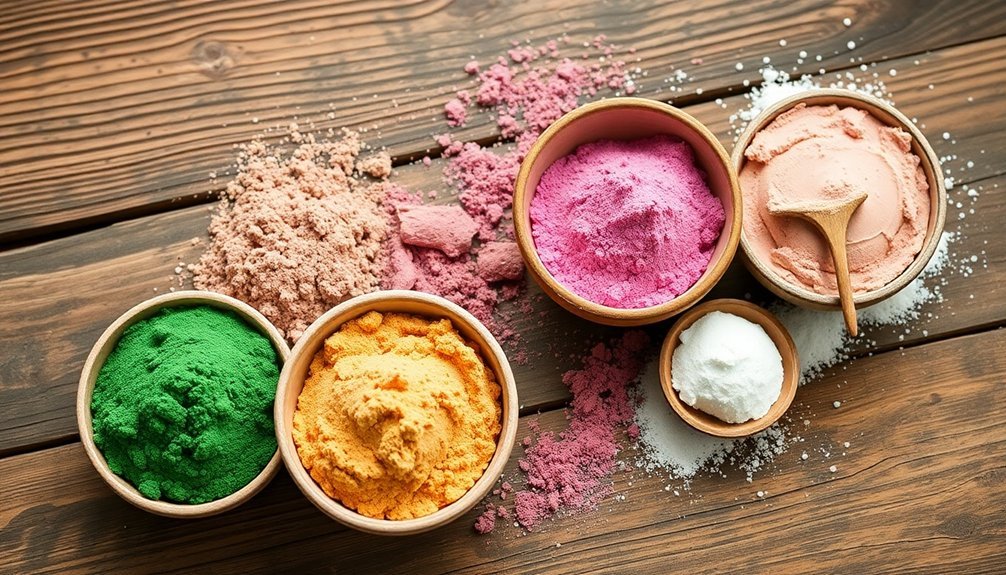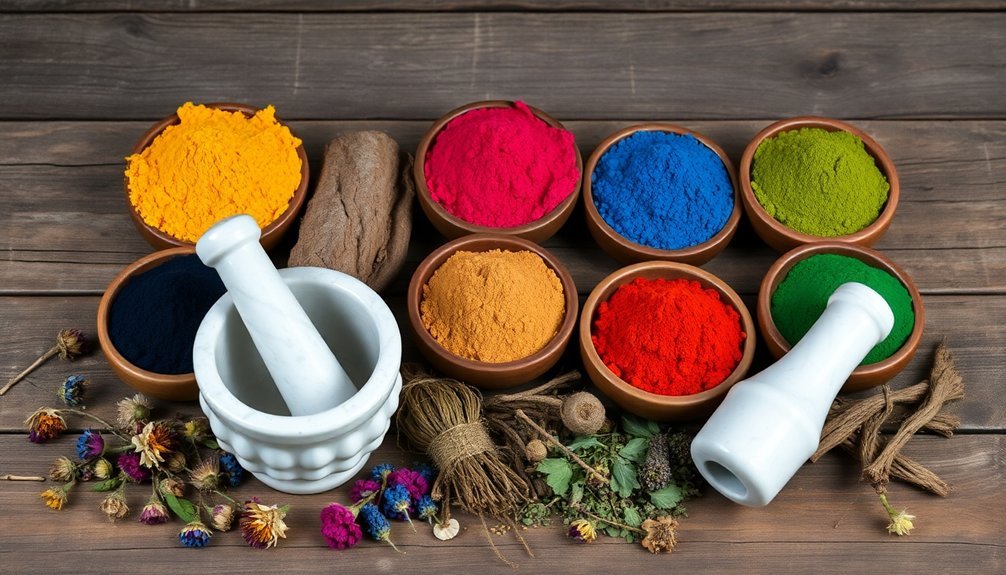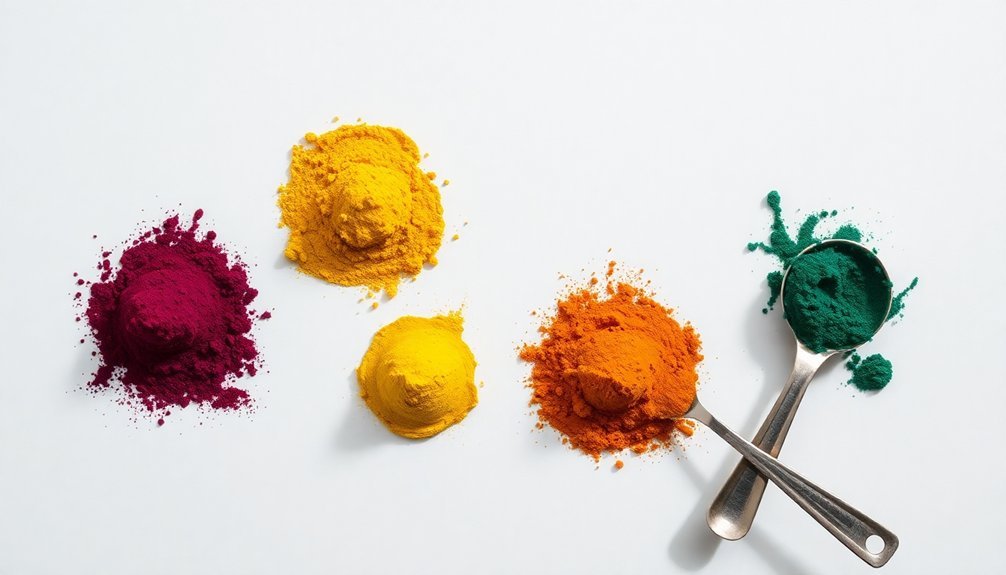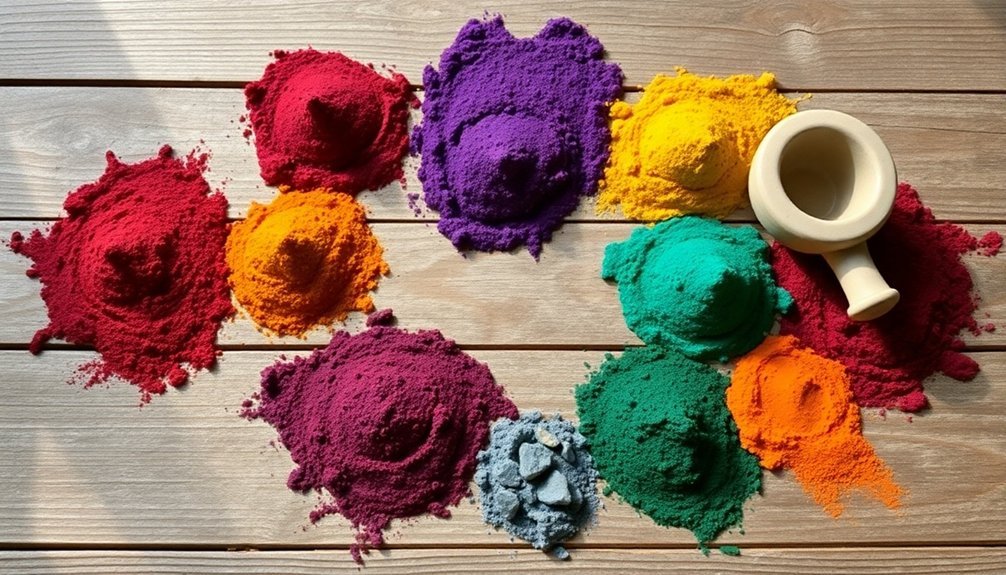Seven reliable pigments will transform your handmade soaps into colorful masterpieces. You can use kaolin clay for gentle white tones, French green clay for earthy greens, and madder root for rosy reds. Turmeric delivers golden yellows, while iron oxides provide stable earth tones. Ultramarine blue creates vibrant azure hues, and skin-safe micas add sparkle. Each natural colorant offers unique properties that enhance your soap's appearance while maintaining its nourishing benefits.
Natural Clay Varieties for Gentle Soap Coloring

Natural clays offer a gentle and reliable approach to soap coloring, providing beautiful earthy tones without the need for artificial additives.
Clay gives soap makers a natural palette of earth-inspired colors while keeping formulations pure and additive-free.
When you're looking for natural soap colorants, you'll find Kaolin Clay is an economical choice at just $1.79, delivering both aesthetic appeal and skin-nourishing benefits to your creations.
French Green Clay stands out as a customer favorite, earning a perfect 5-star rating for its effectiveness in natural soap making.
If you're seeking variety, Sea Clay presents another option at $2.69, maintaining a solid 3.5-star rating among crafters.
Before committing to large batches, you'll want to test your chosen clay in small amounts first, as the final color intensity can vary depending on your soap-making method.
These natural options guarantee you're creating safe, attractive soaps without synthetic ingredients.
Plant-Based Root and Herb Pigments

You'll discover remarkable color potential in root and herb pigments, with options like madder root and turmeric offering vibrant pinks and yellows at concentrations up to 5% of your total soap weight.
When working with raw plant matter, you'll need to properly process and strain the materials to achieve consistent coloring results in your soap batches.
Store your root powders in airtight containers away from direct light to maintain their potency and prevent color degradation over time.
Natural Color Properties
When exploring the vibrant world of soap making, plant-based root and herb pigments offer an impressive palette of natural coloring options.
You'll find that roots, leaves, flowers, and clays provide beautiful hues without the need for synthetic additives.
For rich yellows and oranges, you can rely on turmeric and annatto seeds, while alkanet and gromwell roots create stunning purple shades.
When working with natural colorants, remember to keep their total concentration at or below 5% of your soap's weight for ideal results and safety.
Before committing to a large batch, it's crucial to test your chosen plant-based colorants in small quantities first.
Different soap-making methods – whether cold process, hot process, or melt-and-pour – can greatly affect how these natural pigments behave in your final product.
Root Powder Storage Tips
Proper storage of root and herb pigments plays an essential role in maintaining their vibrant qualities for soap making. To preserve these natural colorants, you'll need to store them in a cool, dry location away from direct sunlight, which can degrade their potency.
Keep your pigments in airtight containers to shield them from moisture and air exposure that could cause clumping or color fading.
Don't forget to label each container with the pigment type and purchase date – this helps you track freshness and guarantee you're using them at their peak.
Store your colorants separately from strong-smelling substances and chemicals, as they can absorb unwanted odors.
Make it a habit to inspect your stored pigments regularly for any changes in color or texture, replacing any that show signs of deterioration.
Processing Raw Plant Matter
Before diving into soap making with raw plant matter, processing your natural colorants correctly guarantees you'll extract the maximum pigmentation potential.
Start by thoroughly cleaning your plant materials, whether you're using roots like madder and alkanet or vibrant flowers and leaves. Once cleaned, dry them completely to prevent mold growth.
To process your plant-based colorants, grind them into a fine powder using a dedicated spice grinder or mortar and pestle. Remember to stick to the maximum recommended usage of 5% of your total soap weight.
This natural alternative to synthetic dyes requires careful testing, as color intensity varies by soap-making method. Create small test batches first, noting how different plant materials behave.
Store your processed pigments in airtight containers away from light to maintain their vibrancy.
Essential Mineral Oxides and Their Properties

Mineral oxides serve as the cornerstone of safe and vibrant soap coloring. You'll find essential mineral oxides, particularly iron oxides and ultramarine pigments, are ideal for your soap making projects due to their stability and non-toxic nature. These cosmetic-grade pigments have been specially formulated to guarantee they're free from heavy metal contamination.
| Pigment Type | Properties |
|---|---|
| Iron Oxide Red | Earthy reds, stable |
| Iron Oxide Yellow | Warm yellows, non-toxic |
| Iron Oxide Brown | Rich earth tones, safe |
| Ultramarine Blue | Vibrant blues, mineral-derived |
| Ultramarine Purple | Deep purples, skin-safe |
When using these pigments, you'll want to keep their concentration at or below 5% of your total soap weight. This guarantees you'll achieve beautiful colors while maintaining your soap's quality and safety standards.
Skin-Safe Cosmetic Grade Micas

When selecting cosmetic grade micas for your soap making, you'll want to review customer ratings and test small batches first to guarantee the colors match your expectations.
Store your micas in airtight containers away from direct sunlight and moisture to maintain their vibrancy and prevent clumping.
You'll find the best results by choosing skin-safe, properly labeled micas that are specifically formulated for personal care products, rather than craft-grade alternatives.
Color Selection Guidelines
Selecting the right colorants for your handmade soap begins with understanding skin-safe cosmetic-grade micas.
When you're choosing colors for your soap, it's essential to prioritize safety and quality to guarantee your final product is both beautiful and gentle on the skin.
- Choose highly-rated cosmetic-grade micas like Angry Rose or Spicy Tomato Brick-Red, which have proven track records with ratings above 4.98.
- Always verify that your colorants are free from harmful contaminants and specifically formulated for skin contact.
- Test your selected micas in small batches first to understand how they'll perform in your specific soap-making process.
Don't be tempted to use synthetic dyes or glitters, even if they're visually appealing.
Instead, stick to skin-safe options that'll maintain your soap's natural properties while providing the vibrant colors you desire.
Proper Storage Methods
Proper storage of skin-safe cosmetic grade micas plays an essential role in maintaining their quality and effectiveness for soap making.
You'll need to store your micas in a cool, dry location away from direct sunlight to preserve their vibrant colors and quality. Choose airtight storage containers or resealable bags that protect against moisture and air exposure, which can degrade the pigments.
Always use clean, dry utensils when handling micas to prevent contamination. Make certain to label your containers with the color name and purchase date, allowing you to track and rotate your inventory effectively.
It's important to inspect your stored micas regularly for signs of clumping or color changes, which indicate they've been exposed to moisture or light. Replace any compromised pigments to guarantee the best results in your soap making projects.
Earth-Derived Natural Colorant Powders

Natural colorant powders derived from the earth offer soap makers a safe and vibrant palette while maintaining an organic approach to their craft.
Earth-derived pigments provide soap artisans with natural color options that enhance both beauty and organic integrity.
When you're working with earth-derived pigments, you'll find options like French Green Clay and Kaolin Clay that provide both color and skin benefits. These natural colorant powders deliver stunning results while keeping your products free from synthetic additives.
For successful application of earth-derived colorants:
- Keep quantities at 5% or less of total soap weight
- Test small batches first, as colors may fade or change with light exposure
- Consider highly-rated options like French Green Clay (5/5 stars) for consistent results
Popular choices include turmeric for bright yellow hues and annatto seeds for vibrant orange tones.
You'll achieve beautiful, natural colors while ensuring your soap remains safe and skin-friendly.
Time-Tested Traditional Spice Colorants
While artisans have colored soaps for centuries, traditional spice colorants remain among the most reliable and vibrant options available. You'll find these natural ingredients create stunning hues while offering potential skin benefits.
| Spice Colorant | Key Characteristics |
|---|---|
| Turmeric | Golden yellow, anti-inflammatory |
| Annatto Seeds | Warm orange, skin-safe |
| Paprika | Reddish tones, natural appeal |
| Test Batches | Small samples recommended |
When working with spice colorants, you'll want to start with turmeric for its rich golden tones, though keep in mind it may fade with light exposure. Annatto seeds provide a dependable orange shade that's perfect for autumn-themed soaps. Before scaling up your production, it's crucial to create test batches with these traditional colorants to determine the ideal concentration for your desired results.
Pure Botanical Extract Pigments
Extracted from nature's richest sources, pure botanical extract pigments offer soap makers a pristine palette of colors without compromising safety or sustainability.
You'll find these safe and eco-friendly colorants derived from roots, leaves, and flowers, providing reliable alternatives to synthetic dyes. When you're working with natural sources, it's essential to purchase from trustworthy suppliers to guarantee purity and effectiveness.
- Turmeric delivers vibrant yellow hues perfect for sunny, cheerful soaps.
- Alkanet root creates deep purple shades for luxurious, royal-looking bars.
- Madder root produces various red tones ideal for rose-themed creations.
Remember that color intensity can vary depending on your soap-making process, so you'll want to test small batches first.
These pure botanical extract pigments won't introduce harmful chemicals to your creations, making them ideal for skin-safe formulations.
Frequently Asked Questions
What Is the Best Pigment for Soap Making?
You'll get the best results using certified cosmetic-grade pigments, especially natural options like activated charcoal and titanium dioxide. They're safe for skin contact and deliver excellent color while maintaining quality in your soap.
Is Mica Safe in Soap Making?
You'll find that cosmetic-grade mica is safe for soap making when purchased from reputable suppliers. Just verify it's properly tested in small batches first, as colors can shift during the cold-process method.
What Is the Difference Between Pigment and Mica?
You'll find pigments are ground colorants that give solid, opaque colors, while mica's a natural mineral that creates shimmering, pearlescent effects. Pigments can be natural or synthetic, but mica's always naturally occurring.
What Are the Best Natural Dyes for Soap Making?
You'll get beautiful colors using turmeric for yellow, annatto seeds for orange, alkanet root for purple, and beetroot powder for pink. Don't forget activated charcoal for black – just keep colorants under 5% total weight.
In Summary
Now you've got a solid foundation for creating beautifully colored soaps using safe, natural pigments. Whether you're working with clays, roots, minerals, or spices, you'll find endless possibilities for customizing your handcrafted soaps. Remember to always source cosmetic-grade ingredients and test small batches first. Don't be afraid to experiment with different combinations to develop your unique color palette while keeping your creations skin-safe and natural.





Leave a Reply